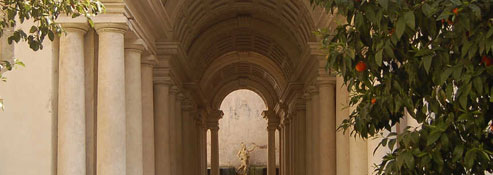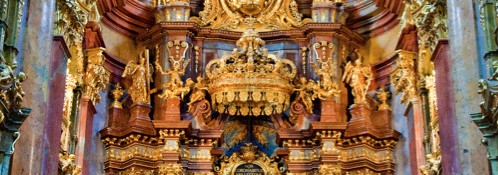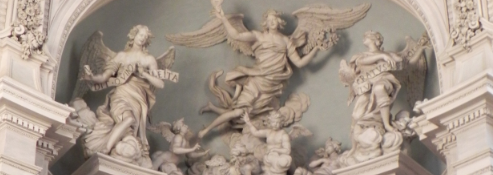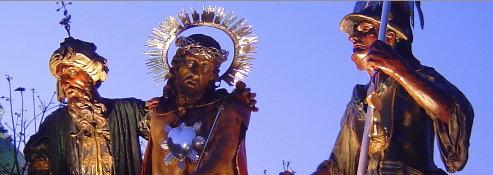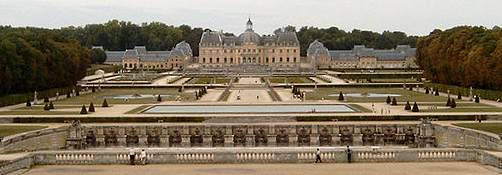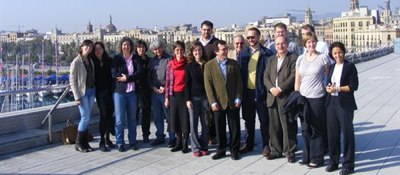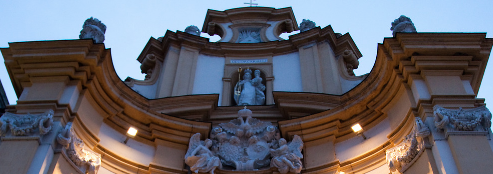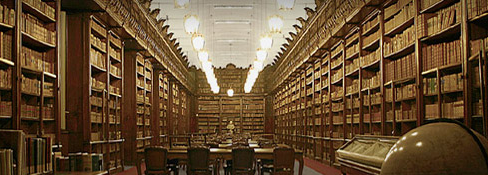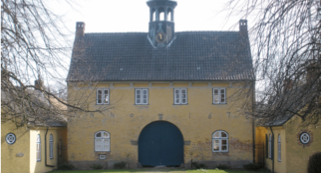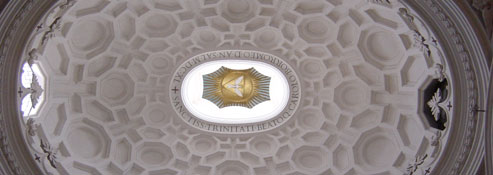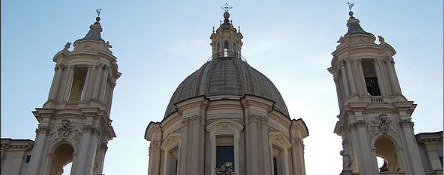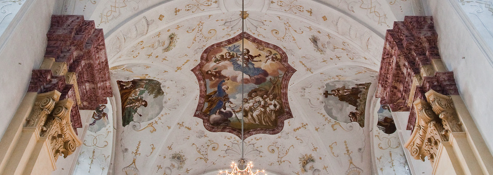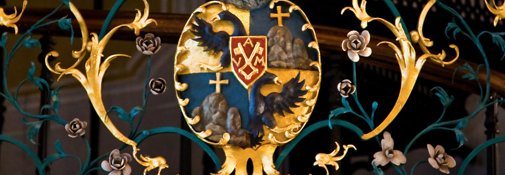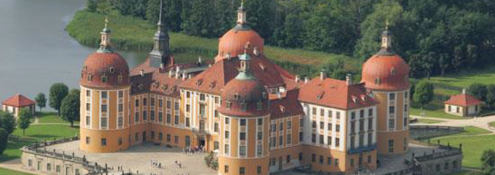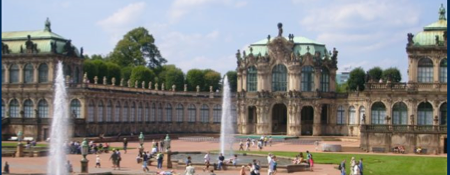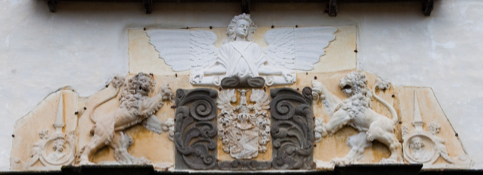In the second half of the sixteenth century, when the Jesuits began their mission of world evangelisation, it was realised that artillery fortifications based the so-called trace italienne of ramparts and mutually-supportive bastions, were becoming insufficient to resist assault unless their early-sixteenth century component dimensional relationships were mathematically adjusted in plan and section to accommodate improved musket ranges and outworks placed in and beyond the ditch to guard all possible approaches. [fig. 1 and 2]
In the conservative world of the Catholic counter-reformation, when mathematical investigation was still considered to be dangerous territory closely associated with alchemy and astrology, an appreciation of the importance of such necessary mathematical applications to fortification developments would have suffered greatly had the Jesuit Order, founded in 1640 by Ignatius of Loyola and better known as the Society of Jesus, not allowed Christoph Clavius to set up a centre of excellence in the mathematical disciplines at the Roman college.
This brilliant Jesuit mathematicus had argued that it would be advantageous for Jesuits to demonstrate and disseminate their superiority in mathematical knowledge when invited to social occasions by the key power players of Catholic Europe, who by this time had become very interested in mathematical applications to 'defensive' and 'offensive' military architecture to realise their ambitions. As a result, many were those Jesuits who started using their mathematical knowledge to win the support and protection of the ruling Catholic nobility of Europe, from the tirades of their many critics.
By 1600, an ever-expanding network of Jesuit colleges and 'seminaries for nobles' having mathematical faculties had been set up in strategic locations facing either Protestant enclaves or Turkish territory, attended by children of noble lineage would have been aware of such applications at a tender age as demonstrated by the many examples of fortification models and fortress warfare which were incorporated physically into Baroque courtly culture. [1] [fig. 3]
The warring princes of non-Spanish Italy provided a good example of their willingness to employ Jesuits in military teaching and consultancy positions. The Roman college and other Jesuit teaching institutions at Bologna, Brescia, Ferrara, Mantova, Modena, Parma, Ravenna, Siena and Trent can be identified as places where the Jesuits Oratio Grassi, Giuseppe Ferroni, Francesco Eschinardi, Giovanni Macrini, Mario Bettini and others taught military architecture. In classroom scenarios packed with international students, the 'terms', 'maxims' and 'geometrical steps' to be followed as well as the 'controversies' of the Italian, Dutch, French and Spanish schools of thought, were carefully explained by these illustrious Jesuit mathematicians.
In France and Portugal, the Jesuits were subjected to national pressures to involve themselves in military affairs. In France, they were asked to participate in expansionist policies which superceded the sixteenth-century Catholic versus Protestant wars of religion but which still depended on Euclid to create better armies, better artillery and better fortifications. The specific requirement to promote the glory of France explains the excellence and thoroughness of Jesuit military teaching, writings and consultancies by the French Jesuits Pierre Bourdin, Georges Fournier, Claude Francois Milliet de Chales, Jean de Breuil and so many others.
The Portuguese Jesuit mathematicus was likewise drawn into a bitter struggle for independence from Spain. Jesuit Provincials in Portugal were often requested to provide the king with able mathematicians to supervise the build-up of fortifications along the country's sensitive border with Spain. In view of the close links that traditionally existed between Spain and the Jesuits (Ignatius of Loyola, the founder of the Jesuits, was a Spaniard), it was inevitable that the activities of Portuguese Jesuits of the likes of Luis Gonzaga, Inacio Vieira and others often met with censure from Rome but despite this, they were allowed to teach military architecture with impunity in the colleges of Lisbon, Coimbra and Évora. In 1651, just a couple of years before a similar faculty was established by Grand Master Jean-Paul Lascaris Castellar in the Jesuit collegium in Malta - the subject of this article - a Jesuit faculty of military mathematics was also established at Elvas, designed to train young officers of the Portuguese army (1651-1666).
In this context, it is understandable that the military role of the Jesuit mathematicus in Italy, France and Portugal was often interpreted as going against the interests of Spain and the Habsburg Empire - and of contradicting precedents which had only allowed Jesuit involvement in military operations against the enemies of the Catholic Church. [2]
The involvement of Jesuit mathematicians of the ilk of Francisco Isasi, Francisco Antonio Camassa, Juan Carlos de la Faille, Claude Richard, José Zaragoza y Vilanova and José Cassani in the so-called Reales Estudios programme of the Colegio Imperial as from 1625 indicate that in Spain Jesuit teaching and consultancy activities within a purposely set up 'De re militari' faculty, were here closely interwoven with a state policy that strove to create an 'invisible force' of educators, advisers and informers that were by reason of their vows, absolutely loyal to the Catholic cause ostentibly championed by the Habsburgs. The military prowess of the Jesuit mathematicus in Madrid - addressing the type of violence-charged climate portrayed in the Spanish film Las aventuras del Capitan Alatriste - affected not only Spain's European dominions in Belgium, Milan, Southern Italy and Sicily but also the vast territories of the Habsburg Empire. In many places, Jesuit colleges and 'seminaries for nobles' supported by well stocked libraries of military books featured prominently in the formation of a vast network of fortification instruction that highlighted the close links that then existed between Jesuit mathematicians, Spanish governors and Catholic army generals. [3]
The compilation of manuscripts and books dealing with military architecture, like fortification teaching and consultancies, was always viewed with suspicion by the Generals of the Jesuit Order. In 1628, Vitelleschi had shown his reservations about the military chair of the Reales Estudios programme in Madrid. In 1648, Carafa had banned teaching and publications on fortifications by means of a directive entitled De Fortificationibus after throwing the defiant Flemish Jesuit Jan Ciermans, then in the service of the king of Portugal, out of the Order. In 1681, General Oliva only reluctantly gave permission to a Jesuit called Francesco Alias to lecture about military mathematics in the Jesuit collegium of Malta, despite a renewed Turkish threat to destroy the ruling Hospitaller Knights of Malta. Although subject to such persistent censure, however, Jesuit works on military architecture multiplied. The grand total of some 110 Jesuit military treatises is indicative of the determination of their mathematician-authors to disseminate their views on fortifications for the sole defence of the Catholic Faith in an age when Catholic armies were becoming increasingly exposed to Protestant influences, partly as the result of the infiltration of unacceptably-tolerant elements in the corps of military engineers serving them. The sixty-two Jesuit treatises that were published in book form were intended to communicate the theoretical fortification knowledge being taught in the Jesuit schools to the people that mattered. Apart from serving as key reference works in college and palace libraries, these Jesuit books on mathematical applications to military architecture sometimes also served as campaign manuals, as the duodecimo format of Georges Fournier's 1648 book suggests. On the other hand, several unpublished Jesuit fortification manuscripts assumed the form of either classroom notes or consultancy reports, as indicated by the two fascinating seventeenth-century reports concerning the fortifications of Malta, written by the Jesuit mathematicians Orazio Grassi and Claude Richard. [4]
Emmanuele Aguilera's biographical sketch of Giacomo Masò (1626-1674) in the book Provinciae Siculae Jesu Ortus et Res Gestae ab Anno 1612 ad Annum 1672 provides an account of the manner by which this Sicilian Jesuit mathematicus, based in the Jesuit collegium in Valletta, managed to focus his attention on the military mathematics while preparing his voluminous classroom notes on the subject, in a manner that was perceived by many to be detrimental to his spiritual calling. This led to a situation where the Jesuit General Nickel would prohibit an enthusiastic Masò from integrating his lecture notes material on fortifications in a textbook of mathematical knowledge that the Jesuit intended to publish after his 1658 transfer from Malta, this despite the fact that Jesuits in France and other countries had been granted permission to publish books on fortifications. Aguilera's narrative contrasts with Sommervogel's terse biographical notes about Masò. [5] This author writes that this Jesuit was born in Syracuse on 5 August 1624, enrolled in the Jesuit Order on 9 January 1642 and, afterwards, was engaged in teaching grammar, philosophy and mathematics in the Jesuit colleges of Rome, Malta and Palermo. Sommervogel further states that Masò left the Jesuits to become a Canon of the Venetian Order of St. George of Alga but, following the suppression of this Order in 1668 by order of Pope Clement IX Rospigliosi, he was appointed to serve as parish priest of S. Tommaso in Syracuse where he died in 1674. The records of the Jesuit college in Rome give the exact date of birth of Giacomo Masò as 31 July 1626. [6]
There are no records concerning his early life history. He had a younger philosopher brother called Antonino, author of Theatrum Philosophicum (1657). In 1653 this Antonino, who had also been studying at the Roman college, wrote a thesis entitled Compendiariae philosophiae theatrum which was presented under the auspices of Hieronymus Colonna (1604-1666), the Cardinal-Protector of the Masò family. [7] After a seemingly uneventful upbringing in Syracuse, Giacomo joined the Messina novitiate of the Sicilian province of the Jesuit Order on 9 January 1642 but this date given by Sommervogel is contradicted by the 1651 list of Jesuits studying at the Roman college which specifies a 21 December 1641 enrolment date, [8] collaborated by the 1655 and 1658 records of the Valletta collegium. [9] By 1649 or thereabouts Masò was studying in Rome where in 1649, [10] he was helping out with the teaching of mathematics as a 'scholasticus'. [11] His professor of mathematics was the famous Jesuit mathematicus Athanasius Kircher. [12]
Masò completed his studies at the Roman college in 1649-1651. He then received instructions to proceed to the college of Montis Regalis (Monreale) outside Palermo. [13] In the Summer of 1653 he received further instructions to proceed to Hospitaller Malta. [fig. 4] Having arrived in Valletta, he was assigned teaching duties in philosophy and mathematics at the Jesuit collegium. [fig. 5] Masò probably travelled to Trapani in 1654 and again to his native Syracuse in 1655. While in Trapani, Masò received a letter from General Nickel, praising his 'impiego suo in mathematica' while another letter from the General to the Jesuit Simone Bonafede dated 14 May 1654 mentioned the delight of Nickel at receiving news of the 'excellent private lessons' on fortification mathematics that Masò had already given to the Grand Master of the Knights of Malta, Jean-Paul Lascaris Castellar, for which reason he had acceded to a request made by Masò to send out books on the mathematical disciplines to Malta. [14]
Before Maso's arrival in Malta, Lascaris had already been thinking of setting up an academy of mathematics, making it clear in the foundation deed signed in 1655 that he believed this subject to be the 'slave and servant' of the disciplines that especially interested 'soldiers and mariners'. [15] Soon after his election, Lascaris had sent a request to his friend, the Jesuit General Vitelleschi, asking him to identify a capable Jesuit mathematicus who would be willing to travel to Malta for the purpose. [16] According to a letter dated 10 January 1637, [17] Vitelleschi had reacted swiftly by sending a letter to Freidrich Tassis - the Provincial of the Flando-Belgica Jesuit province - enquiring about the availability of an illustrious Jesuit professor of the mathematical disciplines and fortification design in Louvain called Willem van Hees (Hesius). [18] Hees proved unwilling to relinquish his position as 'prefect of studies' at the Jesuit college of Ghent [19] and he was subsequently appointed rector of the college of Aalst in 1641. [20] In a fresh effort to please the disappointed Grand Master, the rector of the Jesuit collegium in Malta, Giuseppe Manthia, proposed the name of a Maltese Jesuit called Fabri [21] but his proposal did not find favour in Rome since soon afterwards the new Jesuit General Nickel asked Masò to leave Monreale and proceed to Malta.
The Sicilian Jesuit arrived at the Jesuit college in Valletta in 1653 with clear instructions to run the new academy of mathematics 'to train the Knights (Melitenses Equites) in the mathematical disciplines'. [22] Nickel evidently felt that the interests of the Jesuit Order in Malta would be better served if the new appointee was an expert in fortification mathematics. This was the time of the war of Candia (1645-1669) when Venice, with the help of the Knights of Malta and many volunteers from Northern Europe, was struggling to prevent the island of Crete from falling into the hands of the Turks.
During his six years in Malta (1653-1658), the newly-arrived Jesuit mathematicus did not only apply himself to teaching. Apart from advising the Grand Master on strengthening the defence of Malta against the Turks, [23] he also compiled several manuscripts which were eventually crystallised in his great work entitled 'Trattato dell'Architettura Militare defensiva, et offensiva.' [24] This manuscript on military architecture provided the inspiration for a later 1657 book published in Malta entitled 'Problemi Geometrici Cavati dal Cavaliero F.D. Emanuele Arias y Porres Castigliano della Sacra Religione Gerosolimitano, dal Trattato della Geometria Militare, dettato in Malta dal P. Giacomo Masò della Compagnia di Giesu`, professore della Matematica'. [25] [fig. 6] The introduction to this work reveals an interesting detail about the activities of Masò in Malta. He seems to have spent much time in writing since his student mentioned in the introduction to the book several 'ingegniosissimi trattati,' one of which dealt with military architecture - presumably referring to the above-mentioned manuscript. In the true Jesuit tradition of gathering and communicating scientific knowledge, he had placed a copy of his writings in the library of the collegium in Valletta 'per utilità e esercitio degli Cavalieri di questa Sacra Religione Hierosolimitano'. [26]
Grand Master Lascaris died on 14 August 1657. By October of the following year, Masò had been transferred to Palermo after being involved in an unspecified unpleasant incident for which he had been disciplined by his superiors. [27] Soon after moving into his new living quarters in the Jesuit Collegio Massimo, he again started teaching mathematics. On 31 July 1659 in the sacristy of the church of the Jesuit domus professa in Palermo and in the presence of the Jesuit Provincial Joseph Castelnuovo, Masò took his final vows. In 1659-1661 Masò was engaged in compiling the text of a college textbook entitled 'Corso Matematico del Padre Giacomo Maso, Siracusano, della Compagnia di Gesu, lettore già delle Matematiche nei college di Roma e Malta e nel presente di Palermo'. [28] He however, ran into trouble when he was ordered to remove the part dealing with fortifications, based on his earlier Architettura Militare Defensiva, et Offensiva manuscript which he had written in Malta. As if this was not enough, he was then asked to submit his revised text to a special commission of Revisores who were all skilled theologians of the Sicilian Jesuit province. Their job was to examine and, if necessary, censor his work. All this emerges from correspondence between General Nickel, Provincial Castelnuovo and Masò dated 31 July 1659 and 4 October 1659. The Jesuit mathematicus seems to have been so flabbergasted that when permission to print was finally granted on 25 March 1660, he only published - perhaps as a sign of tacit protest - the fourth volume of the entire work entitled Sferologia. [29] [fig. 7] This 481 folio work was produced in the printing press of Giuseppe Bisagni who in 1661 also published a second important mathematical work by Masò entitled 'Tavola Esattissima, e perpetua per gli Orioli a suono della Mezzanotte, Nascita del Sole, e Mezzogiorno'. [30]
The great crisis in the life of Masò happened in the following year. The 'lack of communication with the Lord' which Aguilera mentions in his book [31] may well have been caused by his intense involvement in the realm of fortification mathematics. [32] According to sources in the Jesuit archives in Rome, Masò, although still in Palermo on 9 December 1662, was by then already searching for ways and means to leave the Jesuit Order, petitioning nullity of his vows since, according to him, they were taken 'against the will of Heaven', then an unacceptable Jewish ancestry and finally, when all else failed, 'coercion' when writing and pronouncing his solemn and simple vows. [33] A satisfactory conclusion to this unpleasant episode was reached on 29 March 1664 when the Jesuit General authorised the transfer of Masò to the moribund Ordine dei Canonici del B. Lorenzo Giustiniani, as the Congregation of S. Giorgio in Alga was sometimes called. [34] After leaving the Jesuit Order in 1664, Masò spent the last ten years of his life in Syracuse. [fig. 8] Having served for some time as the parish priest of the Medieval church of S. Tommaso situated in the Spirduta district in the heart of that city, [35] he met an accidental death - attributed by many Sicilian Jesuits to "Divine intervention" - in his residence at Megara Hyblaea, some twenty kilometres away from Syracuse. The tragic episode that has been so emotionally described in true Baroque literary style by Aguilera, [36] was confirmed in a 6 August 1674 entry kept in a death register of the parish of S. Tommaso. [37] According to this single-sentence entry, 'Don Giacomo Masò' had received the Last Sacraments and was, according to his last wishes, buried in S. Sebastiano which had close historic associations with the Knights of Malta. This church, mentioned by Nuzzo, [38] no longer exists.
When Masò had arrived in Malta in the Summer of 1653 to take up residence in the Jesuit collegium situated in Strada San Giacomo in Valletta close to the Grand Master's sumptuous palace, he would have undoubtedly confirmed all that he had heard and read about a land that had constituted, since 1530, a prime target for Turkish occupation. In this charged atmosphere of confrontation between the Catholic and Muslim worlds, Masò's Trattato dell'Architettura Militare Defensiva, et Offensiva (1653-1655) - written during his sojourn in Malta - would have served a twofold purpose. The manuscript was obviously intended to serve as a portfolio of classroom notes covering Masò's lectures at the new Jesuit academy of fortification mathematics - as explicitly stated by the Jesuit himself who in the introduction to his work clearly expressed his 'burning desire' to record 'in indelible script' all that he had 'explained about military architecture to the most illustrious and most noble Knights of this academy' [39] - a fact that was later also confirmed by his student Arias y Porres in his book on military geometry. [40] The treatise of Masò was also intended for the eventual publication in Malta of what could have been one of best Jesuit books on military architecture, written for the defence 'the true Catholic Faith'. [41] The work was presumably not published because of the sudden transfer of Masò from Malta to Palermo in 1658, which would have interrupted the plan of Arias y Porres to publish the Jesuit's work in its entirety. [42] This was also detrimental to the Knights who lost an opportunity for their brand new printing press [43] to present the Catholic world with what could have been the only official book of the 'Religion of Malta' dealing with the 'dos' and 'do nots' of military architecture in the Baroque age. It has already been mentioned that Maso's final attempt to publish his Trattato material as part of a mathematical textbook in Palermo was also aborted.
The treatise of Giacomo Masò is an indeed remarkable document. The Jesuit's various arguments on military architecture are developed in a well-planned sequence reflecting clarity of thought and a thorough knowledge of the subject possibly based on first-hand field experience. The encyclopaedic knowledge that this treatise contains stands out when compared to other Jesuit works on the fortifications. Introducing his voluminous 377 folio treatise with a reference to 'that famous military architect Vegetius'. [44] Masò`s work was organised into five parts. Part I dealt with the plans of regularly-shaped city fortifications. Part II dealt with the sections of regularly-shaped fortifications. Part III dealt with all aspects of outworks common to both regularly-shaped and irregularly-shaped fortifications. Part IV focused on irregularly-shaped fortifications. Part V dealt with offensive military architecture. All these parts of the treatise evoked - judging by the unpolished style of writing used - the many discussions that would have taken place in the Jesuit's Valletta classroom.
Part I of the treatise contained seven chapters of an introductory nature. The first dealt with terrain conditions. The second dealt with representation, nomenclature and 'maxims' of fortifications. The third focused on 'angle' computation issues. The fourth focused on 'line' computation issues. The fifth discussed the use of trigonometrical tables. The sixth concerned tables of bastions and curtain walls, designed according to the Jesuit's 'first' and 'second' methods of fortification. The seventh chapter concerned another table of bastions and curtain walls, designed according to Masò's 'third' method of fortification.
Part II of the treatise contained five chapters, all concerned with the design of the main line of a fortified front. The first dealt with terraplein issues. The second discussed parapet walls. The third discussed the use of the fausse-braye. [45] This feature is defined by the Jesuit, as a low-lying platform which, he says, was 'invented by the Dutch' to replace the old 'Antemuraglie' and prevent an enemy who would have penetrated the ditch from coming dangerously close to the main line of defence to scale and undermine it. The fourth chapter dealt with the ditch, [46] this serving to cover sortie actions by the defenders, to provide material for the building of the main line of defence with terraplein and stone, to make mining action more difficult and to slow down and delay an enemy assault. The fifth chapter dealt with the covered way and glacis. [47]
Part III of the treatise contained nine chapters, all concerned with the design of outworks. The first chapter dealt with ravelins [48] (defined as detached works placed in the ditch, with or without flanks, meant to protect the curtain wall gateways and the bridges leading to them, to supplement the defence of bastions, to support the demilunes and to make good for any defect in that critical portion of the defence just in front of the main line of fortification). The second chapter dealt with demilunes [49] (defined as detached works placed in the ditch with or without flanks, meant to cover the bastions which, however, had to be introduced with caution so as not to interfere with the artillery fire from the bastion behind). The third chapter dealt with projecting hornworks [50] (defined as those fortifications having 'two long sides' and a front composed of two demi-bastions and a curtain wall, most useful to prevent or delay the enemy advance towards the city-fortress as proved 'by repeated siege experiences'). The fourth chapter dealt with crownworks [51] (defined as detached works composed of two demi-bastions at the ends and a large bastion in the centre, linked by curtain walls and used to act as a forward position to defend any patch of raised ground which, if captured by an enemy, could be used to mount cannon batteries to the detriment of the defenders). The fifth chapter dealt with tenailles [52] (defined as works classified into two categories - single or double - built rapidly and positioned in the ditch to delay attacking troops during sudden attacks). The sixth chapter dealt with traverse works [53] (defined as rapidly improvised works placed at right angles to the main line of defence so as to render it difficult for an advancing enemy to advance at a quick pace, therefore giving valuable time to the defenders to better organise their defence strategy). The seventh chapter discussed cavaliers [54] (compared by Masò - because of their great height - to 'Knights on horseback', these works were considered to be very necessary to observe the approaching movements of an enemy when still at a considerable distance, also to dominate the position of enemy batteries and trenches during siege operations, to supplement the defensive fire from the lower bastion faces and to harass an enemy who would have been so 'fortunate' as to capture a bastion - with the proviso, however, that the cavalier would never be allowed to serve as the principal means of defence). The eight chapter dealt with casemates. [55] The ninth and final chapter of Part III was dominated by two lengthy discussions about drawing fortifications in plan and in section [56] using the tables given in the first and second parts of the treatise.
Part IV of the treatise contained eight chapters, concerned with irregular fortification traces and town planning issues. The first explains the general 'maxims' to be observed in the design of irregularly-shaped fortifications. The second dealt with identification issues. The third discussed the applicability of the given trigonometrical tables. The fourth dealt with problematic terrain contours. The fifth dealt with the design of citadels or 'castles inside the town'. [57] The sixth dealt with sectional issues in irregularly-shaped fortifications. The seventh focused on proposals to amend the fortifications of 'old style towns'. [58] The eight and final chapter of Part IV dealt with squares, streets, gates and bridges of fortified cities. [59]
Part V of the treatise consisted of six chapters and discussed siege works. The first chapter discussed the crucial decisions that would have to be taken during offensive 'just war' operations against the enemies of Catholic Europe. [60] The second chapter dealt with the mathematical considerations of castramentation - setting out of the infantry and cavalry quarters, quarters of the high command and entrenchments. As early modern armies increased in size and complexity and operated routinely in all seasons, this issue was becoming an important topic which Maso must have considered worthy of discussion. The third chapter discussed the principles of approach systems (anticipating Vauban's later and far more sophisticated parallel approach). The fourth chapter dealt with the capture of the covered way. The fifth chapter dealt with ways and means of crossing the ditch and the sixth chapter dealt very briefly with underground navigation.
The above suggests that the contribution of the Jesuit Collegium in Malta to the dissemination of knowledge on fortifications in the Baroque age reveals the dominant presence of a brilliant Jesuit mathematicus who, ironically, was denied the opportunity to achieve the high level of personal prestige that had been attained by other Jesuits in Europe with similar interests in 'De re militari.' It was perhaps Giacomo Masò's greatest disappointment that he had not been able to remain in that laboratory of fortification building that was seventeenth-century Malta and continue teaching military architecture 'with so much wit and with so much art' [61] to those young Knights of Malta who were possibly the only human beings in his tragic life who had really meant something to him. When one considers that the new continental method of designing fortifications using prepared tables of inter-related component dimensions (derived from the time-consuming type of mathematical calculations and trigonometrical knowledge that were so well explained by Masò in Part I of his Trattato), would have represented unchartered waters to all those who were responsible for the defence of the islands of Malta in the 1650's - particularly so at a point in time when there was a lull in the coming and going of high-calibre foreign military engineers [62] - one can understand why a worried Grand Master Lascaris would have nursed high hopes that this expertise vacuum could have been filled by the newly-established academy of military mathematics run by the Jesuits. Not only would have Masò's updated knowledge placed the famous warrior-monk defenders of Malta in a better position to use their cannon and muskets more effectively within the confines of the magnificent array of outworks that had just been designed by the military engineers Pietro Paolo Floriani and and Vincenzo Maculano da Firenzuola at Floriana and Santa Margherita, but the presence of the Jesuit mathematicus would also have greatly helped the resident military engineer Francesco Buonamici, who was more of an artist than a military engineer due to his Accademia di San Luca background, [63] to perform his onerous executive tasks (which included the complex building calculations for a new fortified town in Gozo), with greater understanding and proficiency. Considered from this viewpoint, it would seem that the high standard of Giacomo Masò's disseminated knowledge about mathematical applications to military architecture represents a hitherto underestimated contribution of the Jesuit collegium in Valletta to the building of fortress Malta, succinctly described by Albert Jouvin de Rochefort in 1664 as "une des plus fortes places de l'Univers". [64]
The military mathematics class in run by Maso seems to have been forgotten till 1681 when Grand Master Gregorio Carafa de Roccella (1680-1690) [fig. 9] made two requests dated 1 December 1680 [65] and 24 February 1681 [66] to the Jesuit general Giovanni Paolo Oliva asking him to send over to Malta a replacement. The wording of the first is interesting:
His Eminence the Grand Master wishes to bring over to Malta a learned Jesuit who can teach mathematics to his Knights - He must be a person who is proficient in his profession and able to maintain the Chair (of mathematics) with decorum, also to offer any necessary advice." [67]
The insistence of the Grand Master seems to have produced the desired results since in 1682, the Sicilian Jesuit mathematicus Vincenzo Alias was sent out to Malta to teach here for eighteen years. [68] Well versed in the Hebrew language, Alias' terms of reference were revealed in a letter dated 11 August 1681 which mentions a request made by many Knights of Malta to learn not only about Euclid but particularly about the more practical applications of mathematics to the art of war. [69] At this time, the teaching of military architecture still seems to have required clearance from Rome since the letter also mentioned the fact that the Jesuit's instructions from Rome to teach the military applications of mathematics was only being given in view of the well-known commitment of the Hospitaller Order to the defence of Christendom. [70]
Vincenzo Alias retired from teaching at the age of seventy-six after well serving the Jesuit Order in the capacity of Lector, Professor Mathematicae, Confessor in Templo, Consultor, Admonitor and Praefectus Rerum Spiritualium for many years. The 1685 Catalogus Primus Provinciae Siculae records kept in the Archivum Romanum Societatis Iesu reveal that, by that date, he had already, and very capably, taught Grammer for one year, Rhetoric for two years, Literature for six years, the Hebrew language for ten years and Mathematical disciplines for twenty-four years. He was replaced in 1700 by a younger Jesuit mathematicus called George de Mothu. [71] This French Jesuit's stay on the island was full of problems, mainly derived from his unusual eating and recreational habits. [72] He managed to obtain permission to leave Malta in 1708 [73] to be replaced in 1715 by another Frenchman called Jean Baptiste Thioly [74] who, however, was unable to come to terms with the Maltese language and climate. He only managed to stick Malta for a year, to be immediately replaced by the Sicilian mathematicus Melchior Spedalieri [75] who was in 1719 again replaced by Angelo Aguillera. [76] On arriving in Valletta, Aguillera assumed the professorship of mathematics and also served as rector during the period June 1736 - April 1739. [77] He compiled a 'Trattato dell'Aritmetica Prattica' based on his 1735-1738 lecture notes on the subject. [78] Aguillera's teaching activities in Malta coincided with many important events, not least being the raising of the Jesuit college in Valletta to university status by means of a decree of Grand Master Antonio Manoel de Vilhena [fig. 10] (1722-1736) dated 7 June 1727. [79] The Jesuit mathematicus was in 1743 replaced by another Sicilian called Filippo Arena. [80] Arena was in turn succeeded by three other Sicilian mathematicians - Ignazio Spatafora from Palermo, Francesco Speciale from Nicosia and Placido Cuzzaniti from Messina. [81] In 1764, the French Jesuit Francois de la Maddalena travelled to Malta from Lyon to assume responsibility for the teaching of mathematics, only to be soon afterwards thrown out by Grand Master Emanuel Pinto de Fonseca (1741-1773) [fig. 11] together with all the other Jesuits on 28 April 1768. [82] The notorious despot of Malta, later so much hated by his Knights and his people, had managed to terminate the rich Jesuit heritage of mathematical teaching and its military applications that had been established by Masò in the previous century.
Images
1. 16th-century fortifications

2. 17th-century fortifications

3. Jesuit faculties of the mathematical disciplines

4. Malta

5. The Jesuit college in Valletta - Tommaso Blandino SJ [1582-1629]

6. Problemi Geometrici

7. Corso Matematico

8. Siracusa

9. Grand Master Gregorio Carafa

10. Grand Master Antonio Manoel de Vilhena

11. Grand Master Emanuel Pinto de Fonseca

Notes
1. Denis De Lucca, Jesuits and Fortifications: The Contribution of the Jesuits to Military Architecture in the Baroque Age (Leiden and Boston: Brill Academic publishers, 2012) pp.34-35.
2. De Lucca, 'Jesuits and Fortifications,' pp.78-131.
3. De Lucca, 'Jesuits and Fortifications,'pp.79 and 150.
4. De Lucca, Jesuits and Fortifications,'pp.189-196.
5. A[rchivum] R[omanum] S[ocietatis] I[esu], Carlos S[o]M[mer]V[ogel], Bibliotheque de la Compagnie de Jesus (Brussels, Paris and Tolouse, 1890-1932)] V, p.697.
6. ARSI, Rom[ana].59, Cat[alogus].Trien[nalis] (1649-1651), ff.193 and 204.
7. Santi Correnti, La Sicilia del Seicento:Societa e Cultura (Milano,1976-1988), pp.153 and 270.
8. See n.8.
9. ARSI, Sic[ula].67, Cat.Trien. (1655-1658), ff.75-76 and 243-244.
10. See n.8.
11. Ibid.
12. A 09-08-1655 letter from General Nickel to Masò in Malta (ARSI, Sic.16 II, f.414) mentions that Masò's mathematical knowledge had been praised by Kircher, professor of the mathematical disciplines at the Jesuit Roman college in 1639-1640 and 1644-1646 [ARSI, Rom. 152a, Catalogus Dei Superiori e Professori del Collegio Romano 1551-1773, f.20 and AHSI, 103, a LII (1983) 84 and 89].
13. ARSI, Sic.66, Cat.Trien. (1649-1651), f.49v.
14. For Lascaris' biography, see Paul Mizzi, The Grand Masters of Malta (Malta, 2000) and William Zammit, Printing in Malta in the seventeenth and eighteenth centuries (Malta, 1992). For Masò's trips to Trapani and Syracuse and the mentioned letters see ARSI, Sic.16 II Epist[olae] Gen[eralium Societatis Iesu], ff.283v (Nickel to Masò), 275v (Nickel to Bonafede) and 422 (Nickel to Manthia).
15. Stanley Fiorini, 'The Development of Mathematical Education in Malta to 1798' in Malta - A Case-Study of Cultural Cross-Currents, ed. Stanley Fiorini and Victor Mallia-Milanes (Malta, 1991), pp.111-145. In this work, Fiorini reproduces the foundation deed for the new academy of mathematics from the N[otarial] A[rchives in] V[alletta] records of Notary Pietro Vella, R 476/38 (21-03-1655), ff. 81v-85. According to the N[ational] L[ibrary of] M[alta], A[rchives of the] O[rder of] M[alta]119, f.156v, this academy depended upon income from the popular game known as 'Il Maglio'.
16. I am indebted to Angelo De Bruycher who drew my attention to this information in ARSI, Sic.13, Epist.Gen. (10-01-1637). So insistent was Lascaris to have a Jesuit mathematicus in Valletta that in a later letter I have identified in ARSI, Sic.16 (1), Epist.Gen. (01-01-1654), ff. 230v-231 (Nickel to Provincial of Sicily) it is written that "La matematica chiesta da Mons.Gran Maestro nel collegio di Malta si deve concedere con ogni prontezza". In another letter to the rector of the Collegium Melitense, the Jesuit General stressed that "noi saremo sempre pronti a servire Sua Eminenza e con la matematica e con ogn'altra cosa che potrà venire da noi" [ARSI, Sic.16 (1), Epist.Gen. (01-01-1654), f.229 (Nickel to Manthia)].
17. See n.18.
18. ARSI, SMV, IV, 336-337. Hesius.(1601-1690 ), an architect, authored a book on domes (1690). See also Charles E. O'Neill and Joaquim M. Dominguez, Diccionario Histórico de la Compañia de Jesús Biografico-Tematico (Rome and Madrid, 2001), pp.1917-1918.
19. Ibid.
20. Ibid.
21. ARSI, Sic.16 (II), Epist.Gen. (09-07-1654) f.301 (Nickel to Manthia).
22. This was the wording that had been used in the 10-01-1637 correspondence mentioned in n.18.
23. ARSI, Sic.159, Cat.Brev, f.164 specifies Masò`s duties in Malta as "Professor mathematicae, Consultor".
24. ARSI, SMV, V, p.697.
25. NLM, Libr[eria manuscripts collection], Bc. b. 38.
26. Ibid.
27. ARSI, Sic.17, Epist.Gen. (16-08-1657), f.78 (Nickel to Provincial of Sicily): "Il P. Masò riesce molesto alla disciplina in Malta e pare svogliato -Lo richiama, e dovendo continuassi la matematica, dia successore"
28. ARSI, SMV, V, p.697.
29. NLM, Libr. E. VI. 15. I have found other copies of this work in Palermo (Biblioteca Gonzaga) and Rome (Biblioteca Casanatense). The mentioned letters are found in ARSI, Sic.17, Epist.Gen. (31-07-1659), ff.328-328v (Nickel to Masò) and ff.328v-329 (Nickel to Castelnuovo); Epist.Gen. (04-10-1659), f.348 (Nickel to Masò) and Epist.Gen. (25-03-1660), f.434v (Nickel to Castelnuovo).
30. ARSI, SMV, V, p.697.
31. Aguilera E., Provinciae Siculae Jesu Ortus et Res Gestae ab Anno 1612 ad Annum 1672 (Palermo, 1740) pp.829-831.
32. Ibid.
33. Ibid.
34. ARSI, Sic.19 (I), Epist.Gen. (29-03-1664), f.123v (Nickel to Masò) and f.124 (Nickel to Visconti).
35. For information and plans of the Medieval church of S. Tommaso (1199) see Paolo Giansiracusa, Ortygia (Siracusa, 1980), pp.19-20 and Guido Di Stefano, Monumenti della Sicilia Normanna ( Palermo, 1979), pp. 121-122 and Plate CLXXXII.
36. Aguilera, Provinciae Siculae, pp.829-831.
37. Chiesa di S. Tommaso (Siracusa), Libro Defuncti An.1659 - An.1761, f.31v (06-08-1674): "Don Giacomo Masò, beneficiato di S [to] Thomaso havendo preso tutti i Sacramenti morì e si sepelli` a S [to] Sebastiano". I am indebted to Don Giuseppe Lombardo for giving me permission to examine this document kept in the Pantheon Church, Syracuse.
38. Antonino Nuzzo, Sebastiano di Narbonne di Milano di Roma (Messina, 2001), p.85.
39. B[iblioteche] R[iunite] C[ivica e 'A. Ursino Recupero di] C[atania], Civ. Mss. E. 63, f.7.
40. NLM, Libr. Bc. b. 38, f.5r.
41. BRCC, Civ. Mss E. 63, f.328.
42. NLM, Libr. Bc. b. 38, f.24v.
43. This printing press was inaugurated by Grand Master Lascaris on 25 May 1654 after he had given a license to Pompeo del Fiore to operate it.
44. BRCC, Civ. Mss. E. 63, f.5.
45. Ibid., ff.96-100 ('Delle Falsabraghe').
46. Ibid., ff.101-109 ('Del Fosso').
47. Ibid., ff.110-117('Della Strada Coperta della Contrascarpa, suo parapetto, e spianata').
48. Ibid., ff.123-131 ('Che cosa sia Rivellino, e che serve').
49. Ibid., ff.132-138 ('Che cosa siano Mezze Lune, et a che servono').
50. Ibid., ff.138-150 ('Dell'Opere à Corni').
51. Ibid., ff.151-161 ('Dell`Opere Coronate').
52. Ibid., ff.161-169 ('Delle Tenaglie').
53. Ibid., ff.170-176 ('Delle Traverse'). It is indicative that Masò does not discuss the value of traverses to protect the defenders from flanking fire. It was only at the siege of Ath (1697), where Vauban used a combined form of flanking and ricochet fire,that cannonballs started causing great havoc when they were made to skip over the traverses by striking the ground at a small angle, thus greatly reducing the value of these works.
54. Ibid., ff.177-180 ('Delli Cavalieri').
55. Ibid., ff.181-184 ('Delle Case Matte o Case armate').
56. Ibid., ff.185-210 ('Del Modo di fabricare meccanicam..te in carta le fortificat.ni regolari per mezzo delle Tavole Ichnografiche, et Ortografiche poste nella p.ma parte p.ma di questo trattato and Modo di fare pratticamente il Profilo d'una fortezza per mezzo delle Tavole').
57. Ibid., ff. 286-290 ('Del Modo di fabricare le Cittadelle, ò Castello nelle Città').
58. Ibid., ff. 292-299 ('Del Modo d'emendare e fortificare le Città atte all'antica').
59. Ibid., ff. 300-324 ('Delle Piazze, Strade, Porte, Ponti e da farsi nelle Fortezze').
60. Ibid., ff. 327-328. Masò uses the words 'nelle guerre giuste'.
61. NLM, Libr. Bc. b. 38, f.2r.
62. Alison Hoppen, The Fortifications of Malta by the Order of St. John, 1530-1798, 2nd edn. (Malta, 1999), pp. 285-286.
63. Denis De Lucca, Francesco Buonamici: Painter, Architect and Military Engineer in seventeenth-century Malta and Italy (University of Malta, 2006), pp. 33-34. Buonamici, who was not a mathematician, was very close to the Jesuits since he had designed for them the facades of their college churches in Malta and Trapani.
64. Denis De Lucca, A Description of Baroque Malta by Albert Jouvin de Rochefort (Malta, 2004), pp. 9 and 39.
65. ARSI, Sic.23 (II), Epist. Gen. (01-12-1680) f. 361 (Oliva to Provincial of Sicily).
66. ARSI, Sic.23(II), Epist. Gen.(24-02-1681) f. 384v (Oliva to Rector of Collegium Militense).
67. See n.65.
68. For Alias, b[orn] 17-03-1624 (Messina), e[nrolled In the Jesuit Order] 09-07-1640, d[ied] 07-08-1704 in Malta see ARSI, Sic.162, Cat.Brev., ff.184, 228v, 274v and 322; Sic.163, ff.31, 136, 183, 239, 292 and 439; Sic.164, ff.19v, 102, 202, 283 and 362v. See also AHSI, 103a LII (1983) 84 and 86 which, however, gives his date of birth as 21-10-1624 based on the information found in ARSI, SMV, I, p. 177.Carlos Sommervogel states that Alias, who 'professa a Messine et a Malte les mathematiques' wrote a treatise entitled Trigonarithmus ad auream proportionum nova, facilique methodo expedientam regulam inventus publiceque explicatus a D. Josepho Henrico Messanensi in Collegio Societatis Iesu urbis Messanae, 1670. Sommervogel further states that this treatise was published in Neapolis apud de Bonis 1670 4o pp. 52 et 2 pl.and that its author had also intended to publish several other works.
69. ARSI, Sic.23 (II), Epist. Gen. (11-08-1681) f. 452 (Oliva to Alias).
70. Ibid. The Italian text reads: "Cessan corti le difficoltà per le quali altrove i nostri lettori di matematica si debbono astenere dal trattato della fortificatione, mentre in cotesta reggia dell'Ordine Gerosolmitano tali insegnamenti sono indirizzati alla sola difesa del Christianesimo".
71. Fiorini and Mallia Milanes, Malta, 125, fn.93 (Mothu: b.04-09-1664 in Lyons, e. 08-09-1681 in Chalon-sur-Saone, d.26-03-1728 in Besancon).
72. Ibid., 126, fn.94.
73. Ibid., 126.
74. Ibid., 126, fn.95 (Thioly: b.24-09-1646 in Lyon, e.23-09-1693, d.20-09-1720 in Marseilles). See also AHSI, 103a, LII (1983), 77.
75. Ibid., 126, fn.96 (Spedalieri: b.05-01-1685 in Palermo, e.13-11-1701, d.30-04-1747 in Palermo). See also AHSI, 103a, LII (1983), 84 and 91.
76. Ibid., 126, fn.97 (Aguillera: b.11-08-1676 in Licata, e.08-06-1691, d.27-06-1743 in Malta). See also AHSI, 103a, LII (1983), 84 and 86.
77. Ibid., 126.
78. NLM, Libr.1245.
79. Seminarium Melitense, X (1955) 1-14 (article 'On fixing the foundation date of the Royal University of Malta' by Mons.Vincent Borg).
80. Fiorini and Mallia Milanes, Malta, 127, fn.103 (Arena: b.01-05-1708 in Piazza Armerina, e.14-11-1723, d.1789 in Rome). See also AHSI, 103a, LII (1983), 84 and 86.
81. Ibid., 128, fn.105, 106 and 108 (Spatafora: b.01-10-1704 in Palermo, e.02-12-1719, d. unknown date; Speciale: b.19-10-1729 in Nicosia, e.27-10-1743 d. unknown date and place; Cuzzaniti: b.03-11-1724 in Messina, e.20-11-1738 d.unknown date and place). See also AHSI, 103,a. LII (1983), 84, 87 and 91.
82. Ibid., 128, fn.111 (Maddalena: b.31-12-1723 in Lyon, e.08-09-1738, d. unknown date and place).



